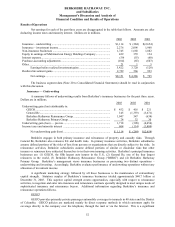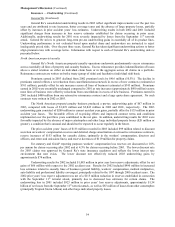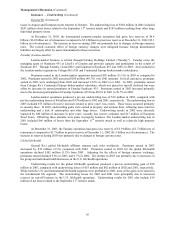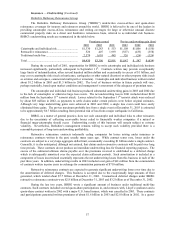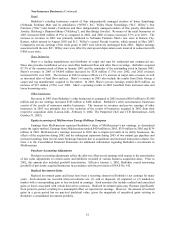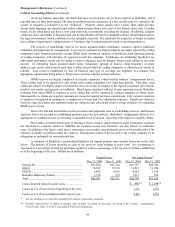Berkshire Hathaway 2003 Annual Report Download - page 56
Download and view the complete annual report
Please find page 56 of the 2003 Berkshire Hathaway annual report below. You can navigate through the pages in the report by either clicking on the pages listed below, or by using the keyword search tool below to find specific information within the annual report.
55
Insurance — Underwriting (Continued)
General Re (Continued)
Management believes the revised estimates in 2003 on prior years’ casualty loss reserves were primarily
due to escalating medical inflation and utilization that adversely affect workers’ compensation and other casualty
lines; and an increased frequency in corporate bankruptcies, scandals and accounting restatements which increased
losses under errors and omissions and directors and officers coverages. Otherwise, reported casualty losses for prior
years were generally consistent with management estimates. In addition to the above listed factors, revised
estimates in 2002 and 2001 for prior years’ loss reserves were due to (1) an increase in claim severity, which has a
leveraged effect on excess of loss coverages provided by General Re by producing a disproportionate increase in
claims exceeding General Re’ s attachment point; (2) broadened coverage terms under General Re’ s reinsurance
contracts during 1997 through 2000; (3) increased ceding companies’ reserve inadequacies, likely arising from
broadened terms and conditions, as well as previously unrecognized premium inadequacies; and (4) increased
primary company insolvencies, which changed historical claim reporting patterns. See the discussion regarding
“Critical Accounting Policies” for information about the processes used in estimating loss reserves.
In addition, General Re continuously estimates its liabilities and related reinsurance recoverables for
environmental and asbestos claims and claim expenses. Most liabilities for such claims arise from exposures in
North America. Environmental and asbestos exposures do not lend themselves to traditional methods of loss
development determination and therefore reserves related to these exposures may be considered less reliable than
reserves for standard lines of business (e.g., automobile). The estimate for environmental and asbestos losses is
composed of four parts: known claims, development on known claims, incurred but not reported (“IBNR”) losses
and direct excess coverage litigation expenses. At December 31, 2003, environmental and asbestos loss reserves for
North America were $1,050 million ($890 million net of reinsurance). As of December 31, 2002 such amounts
totaled $1,161 million ($1,008 million net of reinsurance). The changing legal environment concerning asbestos and
environmental claims has made quantification of potential exposures very difficult. Future changes to the legal
environment may precipitate significant changes in reserves.
Due to the long-tail nature of casualty business, a very high degree of estimation is involved in establishing
loss reserves for current accident year casualty occurrences. Thus, the ultimate level of underwriting gain or loss
with respect to the 2003 accident year will not be fully known for many years. North American property/casualty
loss reserves were $15.5 billion ($14.3 billion net of reinsurance) at December 31, 2003 and $16.2 billion ($14.9
billion net of reinsurance) at December 31, 2002. About 52% of this amount at December 31, 2003 represents
estimates of IBNR losses.
Although loss reserve levels are now believed to be adequate, there can be no guarantees. A relatively
small change in the estimate of net reserves can produce large changes in annual underwriting results. For instance,
a one percentage point change in net loss reserves at year end 2003 would produce a pre-tax underwriting gain or
loss of $143 million, or roughly 4% of premiums earned in 2003. In addition, the timing and magnitude of
catastrophe and large individual property losses are expected to continue to contribute to volatile periodic
underwriting results in the future.
International property/casualty
The international property/casualty operations write quota-share and excess reinsurance on risks around the
world, with its largest markets in Continental Europe and the United Kingdom. International property/casualty
business is written on a direct reinsurance basis primarily through Cologne Re.
Premiums earned in 2003 increased $105 million (5.9%) from 2002 amounts, reflecting the increase in
values of most foreign currencies relative to the U.S. dollar. In local currencies, premiums earned declined 8.1% in
2003 versus 2002. The decrease in premiums earned was primarily due to the non-renewal of unprofitable business
in Continental Europe, the United Kingdom, Latin America and Australia. In local currencies, premiums earned in
2002 declined 2.1% from 2001, primarily due to a substantial decline in premiums in Argentina, the non-renewal of
under-performing business in Continental Europe and parts of Asia, partially offset by increases in the United
Kingdom and Australia.
The international property/casualty operations produced a pre-tax underwriting gain of $38 million during
2003, compared with pre-tax underwriting losses of $315 million and $568 million for 2002 and 2001, respectively.
The net underwriting gain for 2003 included $69 million of gains in the current underwriting year, which reflected
rate increases and the absence of large property losses, and losses of $31 million from increases to reserves for prior
years’ loss occurrences. Results for 2002 included $240 million of net increases to prior years’ loss reserves, and
approximately $107 million in catastrophe and other large individual property losses, principally European flood









